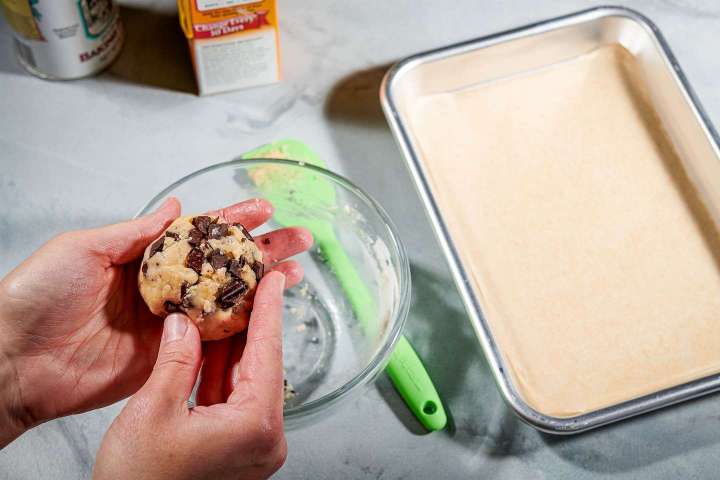One of the things many of us love about baking is its bountiful nature — big batches meant to be shared. But multiple trays of cookies and large layer cakes are not always ideal for solo cooks or small households.
Dessert for one? 5 tips for small-batch baking satisfaction.

I spoke to Kimber and Johnson to gather some of their top tips on baking for one (or a few).
Change your mind-set. Mustering the enthusiasm to cook for one can be challenging enough. But maybe baking falls by the wayside because it feels more like a splurge than a necessity. You’re worth it, though, Kimber says. He sees baking as an outlet for stress relief, and small batches are just the thing for “our daily moments, rather than the six special occasions we might have a year.” It is about pleasure without being saddled by the extravagance and expense of a large recipe. You’ll hardly find a better example of this than his “emergency” chocolate chip cookie, which we’ve dubbed the Single-Serving Chocolate Chip Cookie.
Take advantage of equipment you already have. The great thing about small-batch baking is that a lot of scaled-down recipes work just as well with equipment you already have. Any size batch of muffins can be made using a 12-cup tin, and you can always bake only a few cookies on a regular half-sheet pan. And if you’re already a baker, chances are you have all the bowls and measuring spoons you need. Ramekins are another staple easily adapted to small-batch desserts, as is the 9-by-5-inch loaf pan.
… But buy a few handy extras. If you’re truly committed to the small-batch baking way of life, consider adding a few tools to your kitchen. Kimber swears by mini spatulas and whisks for combining smaller amounts of ingredients and says it can be helpful to have a small pot, such as a butter warmer or milk pan, on hand to make it less likely you’ll scorch milk, sauces or choux pastry by using something too big. He highly recommends a diminutive eighth-sheet pan, great for the aforementioned cookie but just as helpful for kitchen prep and cleanup.
Johnson says the most notable addition to your kitchen equipment might be small tart pans that are about 4 3/4 inches in diameter. He likes a 6-inch cast-iron skillet for skillet cookies or cobblers, which would be perfect for a mini-frittata, too. Similarly, you’ll want 6-inch cake tins if you want the wow factor of layer cakes in a less massive package.
Know what recipes scale down well. If you’re not starting with recipes intended for lower yields, know that most recipes can be successfully scaled down, so long as you’re careful and use common sense, Kimber says. Simple recipes with short ingredient lists are easiest to scale down. When Kimber was developing recipes for his book, cookies, especially egg-free shortbreads, proved very straightforward. Bars are relatively easy to adapt, and both Kimber and Johnson, whose previous book was devoted to brownies, offer recipes designed for a loaf pan.
“Eggs are the biggest hang-up when scaling down,” Johnson says. Scaling down recipes often means math that results in half an egg. How you handle it depends a bit on what you’re making. Using half an extra egg is unlikely to have a dramatic effect on a batch of bars or a half-dozen cookies. For something like one and a half eggs, you can try using one egg and one yolk and save the white for scrambled eggs or an egg white frittata (egg whites can be frozen, no problem). Another option: Skip the eggs and try a vegan alternative, such as a flax egg, egg replacer or applesauce. In his chocolate chip cookie recipe, the egg was going to be so minimal that Kimber just went with 1 1/2 teaspoons of milk instead.
Pay attention and adjust as needed. While baking always relies on attentiveness, it’s especially important if you’ve made scaling tweaks to a recipe. If you scale down a recipe that originally called for a stand mixer, you may find that a hand mixer is a better fit to more efficiently blend the reduced quantities of ingredients. If you’re melting smaller amounts of butter or heating smaller amounts of dairy in the same size pot called for in the original recipe, expect to reduce the time to prevent burning. Bars baked in a smaller pan where the thickness of the batter hasn’t changed — such as moving brownies from a 9-by-13-inch to a 9-by-5-inch pan — may bake quicker. Items moved to a smaller pan resulting in a slightly thicker layer, such as cakes, may take longer. And scaled-down amounts of bread dough might not take as long to knead, Johnson says. The same wisdom applies to cake batter, Kimber says, when overmixing can yield tough, rubbery results.






